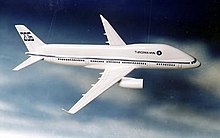Tupolev Tu-204
First introduced in 1989, it was intended to be broadly equivalent to the Boeing 757, with slightly lower range and payload, and had competitive performance and fuel efficiency in its class.The rejection of the Tupolev has various reasons, including no two-member cockpit, and about 13% of avionics (e.g. TCAS) and evacuation ramps, still needing to be replaced by Russian equipment.[10] The Tu-204-100 variant, certified with PS-90A engines, complies with noise regulations described in Chapter 4 of Supplement 16 to ICAO which means it is quieter.The Tu-204 features technologies such as fly-by-wire control systems, a glass cockpit, supercritical wings with winglets, and is available with Russian or foreign avionics.During the test flight safety has been confirmed without the anti-icing system on the bearing surfaces and the aircraft obtained Russian and European certificates.[16] The Tu-204-120 has a maximum takeoff weight of 103 metric tons and a range of 4,600 kilometres (2,500 nmi) with 196 passengers in a two-class seating configuration.[17] This is a version of the Tu-204-300 optimized for shorter routes, featuring smaller wings and an increased cruising speed (to Mach 0.84), which makes it a competitor to the Next Generation Boeing 737.[18] The Tu-206 is a company-funded concept aircraft that, if built, would be used as a testbed for alternative fuels, specifically liquefied natural gas.[21][22] While the Tu-204SM will retain key design and aerodynamic features of the Tu-204-100/100E/100V series, there are numerous upgrades, largely aimed at meeting the current and near-future Russian and international standards, including those of ICAO and Eurocontrol.The upgrades include[21][22] new larger storage bins, multicolored LED lighting, sound-absorbing structures and a modern in-flight entertainment system (IFE).Ilyushin Finance Co. (IFC) said it would complete negotiations with Red Wings for 44 Tu-204SM aircraft in February, to sign a firm order in March 2011.By January 2012 a firm order from Red Wings had not been signed, the stumbling blocks being requests for guarantees of the residual value of the airframes and after-sales support at a cost the same as an equivalent Airbus or Boeing model.[25] It was subsequently announced that Red Wings had cut back its initial commitment from 44 to 15 Tu-204SMs due to delays to the flight-test programme and after the lessor Ilyushin Finance reportedly "lost interest".[33] In March 2022, CEO of Rostec Sergey Chemezov declared a possibility to relaunch big production of Tu-214 due to International sanctions during the Russo-Ukrainian War.[38] The Tu-214ON is an observation version of the Tu-204-200, equipped for Treaty on Open Skies missions and built by Kazan Aircraft Production Association.Vega Radio Engineering Corporation was contracted for the development of airborne surveillance system, ground-based complex and other mission equipment for the aircraft.The Ministry of Defence of the Russian Federation conducted state tests to verify the air and ground equipment of the Tu-214ON aircraft in April 2013.[57] Special-purpose aircraft-control point equipped with a special onboard communication unit SBUS-214 intended for the Ministry of Defence of Russia.The aircraft is built with Russian-made components only, meeting the requirements of the state customers, and has a range of at least 7,200 km (4,500 mi).[61] A flying laboratory based on a serial Tu-214 passenger plane (registration number RA-64507) equipped with a multifunctional flight complex LMK-214.


















Air KoryoVladivostok AirportNarrow-bodyjet airlinerSoviet UnionRussiaManufacturerAviastar SPKazan Aircraft Production AssociationUnited Aircraft CorporationTupolevRed Wings AirlinesCubana AirlinesAviastar-TUVnukovo AirlinesRussiantwin-enginedAviastar-SPBoeing 757fuel efficiencyAeroflotTupolev Tu-154trijetmaiden flightCubanaAviadvigatel PS-90Rolls-Royce RB211UlyanovskeconomyBusiness classnoise regulationsIlyushin Il-96fly-by-wireglass cockpitsupercritical wingswingletsSheremetyevo International AirportMoscowAviadvigatelturbofansPS90A2maximum take-off weightRolls-RoyceVladivostok AirMoscow SheremetyevoAviadvigatel PS-90A2Boeing 737testbedliquefied natural gasEurocontrolflight management systemLCD displayshead-up displays (HUD)electronic flight bagLED lightingin-flight entertainment system (IFE)Iran Air ToursPratt & WhitneyPerm Engine CompanyIrkut MC-21airlineRossiyaSergey ChemezovInternational sanctions during the Russo-Ukrainian WarTreaty on Open SkiesVega Radio Engineering Corporationthermographic cameraSide looking airborne radarMinistry of Defence of the Russian FederationAntonov An-30CrimeaSynthetic Aperture RadarSIGINTSea of JapanBorisoglebskoye airfieldRussian Air Forceits baseLatakiaMinistry of Defence of RussiaTupolev PAK DARed WingsRussian PostAir China CargoAviastar-TU Co. LtdCubana de AviaciónKosmos AirlinesRoscosmosRussian Aerospace ForcesUVT AeroAeroflot'sS7 AirlinesSiberia AirlinesVnukovo International AirportDalaviaCainiaoHangzhouwritten offCairo AviationKavminvodyaviaKras AirRossiya AirlinesTransaeroVladivostok AviaBlue WingsOmskaviaSiberia Airlines Flight 852Omsk Airportwritten off in a 2010 accidentAviastar-TU Flight 1906Moscow Domodedovo AirportМАКRed Wings Airlines Flight 9268Pardubice AirportNovosibirskTolmachevo AirportUfa International AirportRosaviatsiaHangzhou Xiaoshan International AirportAircraft industry of RussiaTupolev Tu-334Airbus A321Boeing 737-900ERMcDonnell Douglas MD-90List of jet airlinersEuropean Aviation Safety AgencyWayback Machine